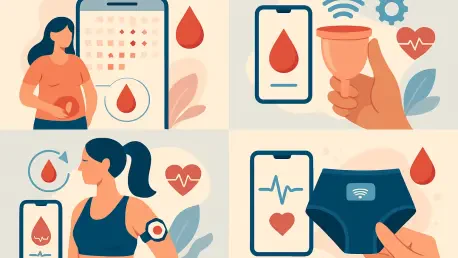Imagine a world where menstrual products not only manage a natural bodily function but also safeguard health, protect the environment, and empower millions of women globally by breaking down barriers of access and stigma. For too long, menstrual health has been an underfunded and overlooked field, leaving countless individuals to grapple with limited options and persistent challenges. Yet, technology is now stepping in to transform this landscape, offering innovative solutions that address period poverty, reduce environmental waste, and enhance women’s health diagnostics. This analysis dives into the surge of menstrual health technology, spotlighting advancements like cutting-edge menstrual cup designs, exploring real-world impacts, sharing expert perspectives, and envisioning future possibilities that could redefine women’s wellness on a global scale. The journey ahead promises to unpack how these innovations are reshaping lives and setting a new standard for care.
The Rise of Menstrual Health Tech
Market Growth and Adoption Trends
The demand for sustainable menstrual products has soared in recent years, reflecting a broader shift in consumer preferences toward eco-friendly and cost-effective alternatives. Industry reports indicate that the global menstrual cup market is projected to grow significantly from this year to 2027, driven by rising awareness of environmental issues linked to disposable pads and tampons. Studies show that reusable options, such as menstrual cups, are gaining traction, with adoption rates climbing as educational campaigns highlight their benefits over single-use products.
This growth is not merely a trend but a response to pressing global needs. In many regions, disposable products contribute to massive waste, with billions of items ending up in landfills annually. As sustainability becomes a priority for consumers, manufacturers are responding with innovations that promise durability and reduced environmental footprints, positioning menstrual health tech as a key player in the green movement.
Moreover, the shift is supported by increasing accessibility through online platforms and retail expansions, making these products available to diverse demographics. Governments and NGOs are also stepping in, promoting reusable menstrual solutions in low-income areas to combat period poverty. This convergence of market dynamics and social initiatives underscores a pivotal moment in the industry’s evolution.
Breakthrough Innovations in Action
At the forefront of menstrual health technology is a groundbreaking menstrual cup design developed by researchers at McMaster University. This innovation enhances safety and usability with lubricant-infused silicone that repels viruses and bacteria, eliminating the cumbersome need to boil the cup between uses. Such a feature tackles a major hurdle for users who find traditional maintenance methods inconvenient or inaccessible.
Complementing this advancement is a flushable tablet made from a highly absorbent, seaweed-based material, designed to minimize spills during removal—a common deterrent for potential adopters. Inspired by products like the Bfree Cup, this design prioritizes user comfort and hygiene, making the transition to reusable options more appealing. The seamless integration of these features represents a leap forward in addressing practical barriers.
Real-world applications of such technologies are already making waves. By focusing on ease of use, these cups are being introduced in communities where cultural or logistical challenges have historically limited adoption. Pilot programs in various regions demonstrate how these innovations can empower users by providing dignified and sustainable menstrual care, paving the way for broader acceptance across diverse populations.
Voices Shaping the Future of Menstrual Care
The conversation around menstrual health tech is enriched by insights from leading experts who highlight both the urgency and potential of these innovations. Zeinab Hosseinidoust and Tohid Didar, associate professors at McMaster University, point out the historical stagnation in menstrual care, emphasizing that new technologies like advanced menstrual cups could dramatically improve quality of life. Their vision is rooted in a commitment to breaking through decades of neglect in this field.
Industry leaders bring another critical perspective to the table. Leisa Hirtz of Women’s Global Health Innovations underscores the social impact of tackling period poverty, noting that accessible menstrual products can enhance education and employment opportunities for girls and women. She also advocates for improved reproductive health diagnostics, suggesting that technology can bridge gaps in care for underserved communities worldwide.
Adding a futuristic lens, Wei Gao from Caltech envisions a transformative role for biosensors and artificial intelligence in menstrual products. By integrating such tools, future designs could detect early signs of health issues like infections or chronic conditions directly through menstrual blood analysis. This convergence of wearable tech and health monitoring, likened to the functionality of smartwatches, promises to redefine proactive care and empower users with actionable health insights.
Looking Ahead: The Future of Menstrual Health Technology
The horizon of menstrual health tech brims with potential, particularly in embedding sensors within products to monitor for conditions such as endometriosis, urinary tract infections, or even blood-borne illnesses. Such advancements could turn a routine item into a powerful diagnostic tool, enabling early intervention and personalized health management. The prospect of leveraging menstrual blood as a rich source of biological data opens unprecedented avenues for women’s health research.
Beyond diagnostics, the implications of these technologies extend to sustainability and equity. Reusable products significantly cut down on environmental waste compared to disposable alternatives, addressing a critical ecological concern. Additionally, scalable solutions tailored for low-income regions could dismantle barriers to access, ensuring that menstrual care becomes a right rather than a privilege, thus fostering social inclusion on a global scale.
Challenges remain, including technological hurdles, production costs, and cultural stigmas that may slow adoption in certain areas. However, optimistic scenarios suggest that with continued investment, public awareness campaigns, and cross-sector collaboration, these obstacles can be overcome. The vision of widespread integration of smart menstrual products holds the promise of a healthier, more equitable future for women everywhere.
A New Era for Women’s Health
Reflecting on the strides made, it becomes evident that innovations like the McMaster University menstrual cup mark a turning point with immediate benefits in safety, usability, and sustainability. The long-term vision of incorporating health-monitoring technologies further elevates the potential to transform women’s wellness globally. These developments stand as a testament to the power of targeted innovation in addressing entrenched issues.
The critical role of menstrual health tech in confronting global challenges like environmental waste, equity in access, and proactive health management emerges as a defining narrative. Each advancement contributes to a broader movement that prioritizes women’s dignity and well-being. The impact resonates across communities, proving that technology can be a catalyst for systemic change.
Looking ahead, the path forward demands sustained momentum through strategic partnerships, funding for research, and policies that support the integration of these solutions into mainstream healthcare. Bridging the gap between innovation and implementation remains essential to ensure that every woman, regardless of circumstance, can benefit from these life-changing tools. The journey has just begun, but the foundation laid offers hope for a more inclusive and empowered tomorrow.









